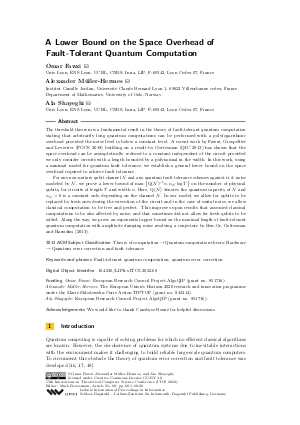@InProceedings{fawzi_et_al:LIPIcs.ITCS.2022.68,
author = {Fawzi, Omar and M\"{u}ller-Hermes, Alexander and Shayeghi, Ala},
title = {{A Lower Bound on the Space Overhead of Fault-Tolerant Quantum Computation}},
booktitle = {13th Innovations in Theoretical Computer Science Conference (ITCS 2022)},
pages = {68:1--68:20},
series = {Leibniz International Proceedings in Informatics (LIPIcs)},
ISBN = {978-3-95977-217-4},
ISSN = {1868-8969},
year = {2022},
volume = {215},
editor = {Braverman, Mark},
publisher = {Schloss Dagstuhl -- Leibniz-Zentrum f{\"u}r Informatik},
address = {Dagstuhl, Germany},
URL = {https://drops.dagstuhl.de/entities/document/10.4230/LIPIcs.ITCS.2022.68},
URN = {urn:nbn:de:0030-drops-156649},
doi = {10.4230/LIPIcs.ITCS.2022.68},
annote = {Keywords: Fault-tolerant quantum computation, quantum error correction}
}

 Creative Commons Attribution 4.0 International license
Creative Commons Attribution 4.0 International license











